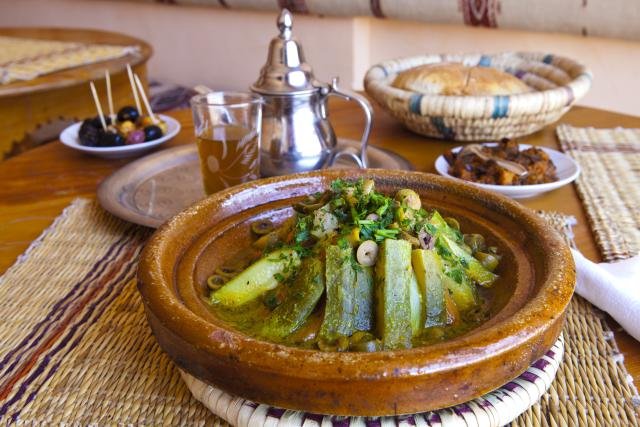How to Use a Moroccan Tagine
Many Moroccan dishes take their name from a tagine, the clay or ceramic pot, in which they were traditionally cooked. Although urban Moroccans are more inclined to use modern cooking utensils such as pressure cookers when making stews, tagines are still preferred by those who appreciate the unique, slowly cooked taste that the crockery imparts to the food. In addition, tagines remains the cooking utensils of choice in many rural areas as a matter of cultural norms.
Before a new tagine can be used, you must spice it up so that it is strengthened to withstand moderate cooking temperatures. Once the tagine is seasoned, how to cook in a tagine - step-by-step photos show you how easy it is to use. But there is more to know - cooking in a tagine is different than cooking in a conventional pot in a number of ways.
presentation
The Tagine doubles as a cooking vessel as well as a serving dish, which keeps the food warm. They are traditionally eaten together; Diners gather around the Tagine and eat by hand, with pieces of Moroccan bread to scoop meat, vegetables and sauce. Since you will not stir during cooking, pay attention to how you arrange or cut the ingredients for a beautiful table presentation.
Cooking with a tagine
Tagines are most commonly used on the stove, but can also be placed in the oven. When cooking with a tagine on the stove, the use of an inexpensive diffuser between the tagine and the heat source is essential.
A diffuser is a flat metal paddle that sits between the torch and the tagine and, as the name implies, diffuses the heat so that the ceramic does not crack and break.
The tagine should also be used only over low to moderate heat to avoid damaging the tagine or scorching the food; Use only as much heat as necessary for maintaining a cook.
Tagines can also be cooked over small fires or in braziers over charcoal. If you are trying to be one of these methods be aware that it can be difficult to maintain a sufficiently low temperature. It is best to use a small amount of charcoal or wood to establish a heat source, and then regularly feed small handful of new fuel to burn the fire or embers. This way you avoid excessive heat.
Avoid exposing the tagine to extreme temperature changes, which can cause Tagine to crack. For example, do not add very hot liquids to a cold tagine (and vice versa) and do not put hot tagine on a very cold surface. If you use a clay or ceramic label in an oven, place the cold day in a cold oven on a rack and then set the temperature to not more than 325 F (160 C) to 350 F (180 ° C).
Some recipes can start tanning the meat at the beginning, but that really is not necessary when you cook in a tagine. You will find that Tagine recipes for adding vegetables and meat to the ship begin at the beginning. This differs from the conventional pot-cookery, where vegetables are added only after the meat has been added.
Tagine fluids
Oil is essential for tagine cooking; Do not be overly careful when you use it or you will end up with watery sauce or possibly scorched ingredients.
In most recipes for 4 to 6 people, you need between 1/4 to 1/3 cup of oil (sometimes part of butter), which will mix with cooking liquids to make plenty of sauce for shoveling with bread. Choose olive oil for the best taste (and its health benefits). Those with dietary or health concerns can simply avoid the sauce while eating.
Less water is required when cooking in a tagine because the cone-shaped top vapor evaporates and returns to the dish. If you are wrong by adding too much water, reduce the liquids to a thick sauce at the end of cooking as an aqueous sauce is not desirable.
It may take some time for a large volume of liquid in a tagine to be reduced. If the dish is otherwise done, you can carefully pour out the liquids to quickly reduce in a small pan, then return the thickened sauce back to the tagine.
Tagines take time
When using a tagine patience is required; Let the tagine reach simmer slowly and know that poultry takes about 2 hours to cook, while beef or lamb may take up to 4 hours.

That's look very delicious . Thanks for sharing this. Have a nice day. @hasaan
Thanks you sharing this. Have a nice day